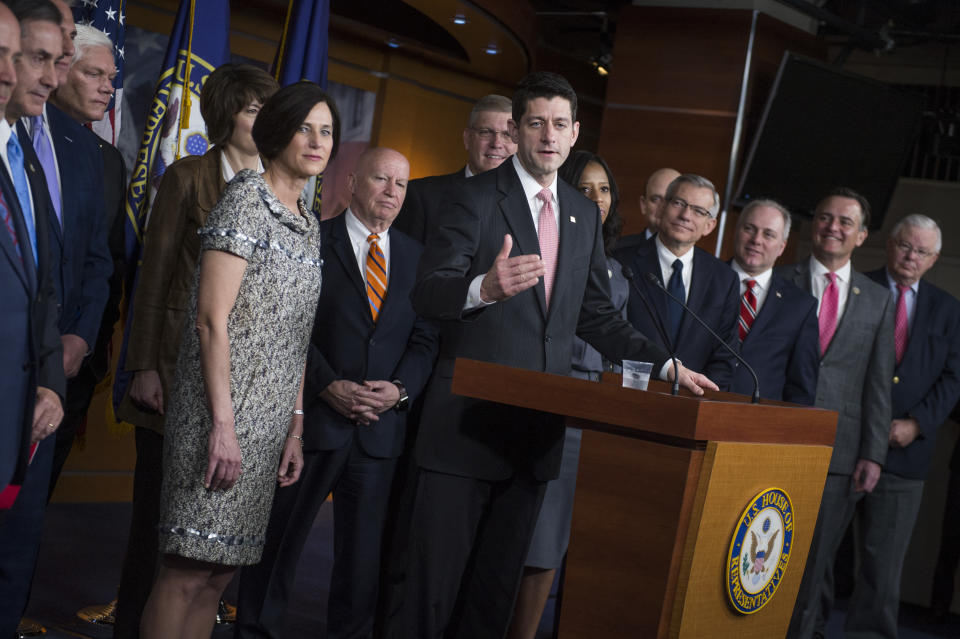The bellwether district that could portend a 2018 Democratic wave

LOS ANGELES — At first glance, Rep. Mimi Walters doesn’t seem like the sort of Republican who’s about to lose her job.
A former investment banker who climbed the Republican ladder in ritzy Laguna Niguel, Calif., before heading to Washington, D.C., Walters has always felt like a good fit for California’s 45th Congressional District — a conservative-leaning, business-oriented patch of suburban Orange County, itself a traditional GOP stronghold. In 2014, voters there first elected Walters to Congress by 30 percentage points; two years later she won reelection by 17 points, even as Donald Trump lost the district to Hillary Clinton by 5.
Clinton’s win was unprecedented — no Democratic presidential candidate had ever captured CA-45 before — and thanks to demographic changes and local anti-Trump sentiment, the former secretary of state also flipped the rest of Orange County. Yet while Walters’s fellow O.C. Republicans have suddenly found themselves in the hot seat as a result — Reps. Darrell Issa and Ed Royce decided to retire, setting off fierce succession fights, and Rep. Dana Rohrabacher faces several strong Democratic and Republican opponents — Walters has largely flown under the radar, the assumption being that she’s the safest of the lot.
But what if the very factors that make Walters seem less vulnerable than her GOP neighbors are same factors that could make her reelection campaign 2018’s best bellwether: the race to watch for signs not just of a Democratic win, but of a Democratic wave?
To regain control of the House, Democrats need to net 24 seats. That seems increasingly doable: The party is performing better than Republicans in generic ballot polls — surveys in which people are asked which party they would support in a congressional election — and President Trump’s approval rating is historically low. Swings of 24 or more seats aren’t historically uncommon, either; they’ve happened in half the midterm elections since 1994.
A wave election, however, would be something else: A transcontinental tide more akin to 2010, when the GOP’s tea party momentum was so strong that it didn’t really matter how solid a particular incumbent was, or how salient some local issue. The Republican Party flipped 63 seats, and the House, and there wasn’t much any individual Democrat could do about it.
Which is where Walters comes in.
In three key ways, her reelection fight is typical of 2018 as a whole — and that’s why it could be telling.
The first factor is Walters herself. Unlike Issa or Rohrabacher — or any Republican running in a Trump-era special election, over which Democrats have obsessed and in which they have overperformed — Walters has not been the focus of national controversy or the target of national Democratic hostility. Issa was an aggressive antagonist of Barack Obama; Rohrabacher has been called Vladimir Putin’s “favorite congressman.” Walters, in contrast, is not a name politician; she is not a left-wing bête noire. She is, instead, a perfectly ordinary, mostly overlooked Republican incumbent, with views that mirror the party consensus. If Walters were to lose in November, it wouldn’t be because she is exceptional in some way; the same would be true if she were to win. She is the opposite of an outlier.

Even Walters’s relationship to Trump is typical. Like most of the rest of the Republican Party, she has wagered that it will benefit her more to stick with the president than to strike out against him, despite his many deviations from conservative orthodoxy and decorum.
Initially Walters supported Jeb Bush for president, then Marco Rubio; she only came around to Trump after her preferred candidates tanked. But when Trump’s “Access Hollywood” tape surfaced shortly before the 2016 election, Walters refused to rescind her endorsement, or to comment in any way. And since the start of his administration she has compiled one of the most pro-Trump records in the House, voting in line with the president’s position 98.6 percent of the time, according to FiveThirtyEight — including votes to repeal the Affordable Care Act and pass Trump’s tax plan, both decisions that were broadly unpopular in California, where many voters rely on the state’s version of Obamacare and will lose valuable deductions under the new tax law.
In short, if the 2018 midterms are a referendum on the president, as most midterms are, Walters hasn’t given voters inclined to vote against Trump any particular reason to vote for her. Their agendas are identical.
The second “typical” factor at work in CA-45 is Walters’s Democratic opposition. Ever since Conor Lamb, a somewhat moderate 33-year-old Marine and former federal prosecutor, defeated his Republican rival, Rick Saccone, earlier this month in PA-18, a district that Trump won by 20 percentage points, politicos have argued over whether Lamb was a “political unicorn” — an impossibly perfect one-off candidate whose victory had more to do with his own performance than any underlying trend. The same went for newly minted Sen. Doug Jones, the Democrat who last year defeated accused pedophile Roy Moore in deep-red Alabama. Democrats can’t possibly hope to run such idiosyncratically well-suited challengers nationwide, the thinking goes — and therefore they can’t possibly hope to keep scoring such big upsets.
This is unlikely to be an issue in Walters’s district. There are four Democrats angling to unseat the two-term congresswoman, and none of them are obvious unicorns. Instead, they make up a remarkably representative cross-section of the Democratic Party’s class of 2018, which is defined by its abundance of rookie candidates, many of them women and/or minorities, who have decided to run for office in order to “resist” Trump’s agenda. There’s Katie Porter, 43, a Harvard-educated consumer protection attorney and law professor at the University of California, Irvine, who has worked with Sen. Elizabeth Warren and Sen. Kamala Harris. There’s Dave Min, 42, another Harvard-educated UC-Irvine law professor and a former economic aide to Senate Minority Leader Chuck Schumer. There’s Brian Forde, 37, a former tech adviser in the Obama White House. And there’s Kia Hamadanchy, 32, the son of Iranian immigrants and a former adviser to Ohio Sen. Sherrod Brown.

Unlike Walters, who was a city councilwoman, mayor, state assemblywoman and state senator before running for Congress, none of her Democratic challengers has ever campaigned for elected office before. None is personally wealthy (like, say, entrepreneur Harley Rouda, who is running to replace Rohrabacher in CA-48). None has been touted as a top Democratic Congressional Campaign Committee recruit (like, say, stem-cell pioneer Hans Keirstead, who is also competing in CA-48). And none has benefited from a surge in out-of-state attention and donations (like, say, prosecutor Andrew Janz, who has become a progressive cause célèbre because he is battling controversial Trump loyalist Devin Nunes in CA-22). In terms of experience, fundraising, connections, national interest and raw political talent, each CA-45 challenger is close to the 2018 Democratic mean. They are your quintessential resistance candidates.
Their primary clash has been typical as well. (In California’s nonpartisan primary system, the top two finishers proceed to the general election regardless of whether they’re Democrats, Republicans or independents; with Walters a lock for first, the fight for second place basically amounts to a Democratic primary contest.) No clear frontrunner has emerged, and the two most prominent candidates, Porter and Min, have been staging a small-scale version of the argument dividing the Democratic Party as a whole: Should Dems run as proud progressives and hope the base turns out in 2018? Or should they try to convert disillusioned Trump voters by burnishing their centrist credentials?
Porter has chosen the first path, touting her endorsements from left-wing icons Warren and Harris and pushing for single-payer health care; Min has hewed a little closer to the center, opposing Medicare for All as “a tremendous tax increase” that wouldn’t play well in such “a conservative district,” according to his campaign manager. (“Dave is not the candidate who is furthest to the left,” she added.) The race has been very close, with Min just barely clinching the state party’s endorsement at last month’s convention — his slim margin triggered a bitter floor fight — and Porter leading in some recent polls.
Whatever happens in California’s June 5 primary, the surviving Democrat is likely to have survived because his or her campaign was more in tune with the mood of the party. And if a Democrat defeats Walters in November, individual attributes probably won’t be the biggest reason, either. Walters has enough advantages — money, incumbency, local political infrastructure — that her Democratic challenger will almost certainly need to ride a national wave to win.
Which brings us to the last “typical” aspect of the CA-45 contest: the district itself. Even though Clinton won there by more than 5 points — and even though Republicans have an 8-point registration advantage — its “partisan lean,” according to FiveThirtyEight, is actually tiny: just 1 or 2 percentage points in the GOP’s favor. This means that in presidential elections, with presidential-level turnout, the results in CA-45 almost exactly mirror the national results. The district has become a bellwether of sorts.

Of course, midterm elections aren’t presidential elections, and a lot of voters — especially Democratic voters — tend to skip them. But demographics could play a part here as well, as Clare Malone of FiveThirtyEight has also pointed out. CA-45 is much more diverse than it was in Ronald Reagan’s day, with a population that is 18 percent Latino and 22 percent Asian; it’s also far more educated than the country at large, with 79.3 percent of residents having completed some college or more, versus 59 percent overall. In 2016, Trump underperformed among white college graduates, and even lost college-educated women to Clinton by 7 percentage points. Combine that weakness with Trump’s widespread unpopularity among Latinos and other minorities, and you start to see why CA-45 (and the rest of Orange County) flipped to Clinton: Trump was a particularly bad fit for its evolving electorate.
And so, if any voting groups are going to fuel an anti-Trump tsunami in 2018, it’s these two: white suburban college grads and minorities. Both have been telling pollsters they disapprove of the president’s job performance in record numbers. Both have been propelling Democrats to victory in special elections. And CA-45 has both in droves, making it a perfect testing ground for the larger proposition.
Is Mimi Walters the most endangered GOP incumbent of 2018? Far from it. But due to the demographics of her district, the nature of her Democratic challengers and her own low-profile, pro-Trump orthodoxy, she may be the most typical — and telling. If you’re searching for signs of a Democratic wave, watch Walters. It could start sweeping through her corner of California first.
Read more from Yahoo News:



